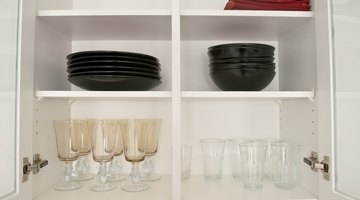How to Install Self Closing Hidden Hinges on Existing Cabinets
A kitchen cabinet update doesn't have to cost thousands. Sometimes small details like cabinet pulls and even hinges can make a big difference in the overall look of your room. Removing old overlay hinges and replacing them with hidden hinges can give your kitchen a sleeker, more modern look.

Using hinges that are not only hidden, but also self closing, improves function and style. Note that a self-closing hinge does not close fully open doors, but holds doors closed.
Things You Will Need
- Phillips screwdriver
- Measuring tape
- 35 mm Forstner bit
- Drill press
-
Measure 4 inches down from the top edge and 4 inches up from the bottom edge on the hinge side of the back of each door. Mark a spot 1/2 inch over from the back edge at each point. This is the center point for the door side of your hinge.
-
Bore out the holes on the doors where marked with a 35 mm Forstner bit on a drill press.
-
Measure any overlay on the cabinet door. "Overlay" refers to the amount the cabinet door extends over the frame. According to "Fine Homebuilding," cabinet doors may be "inset," meaning wholly inside the frame of the cabinet; overlay, meaning doors extend 3/4 inch or more over the frame and the frame usually does not show at all when doors are closed; or half-overlay, meaning there is an overlap of 3/8 inch to 1/2 inch with the door sitting on top of the visible frame.
-
Subtract any overlay from 4 inches. Mark that measurement down from the top and up from the bottom on the inside edge of your cabinet frame. This is the center point for the frame side of the hinge.
-
Hold the frame side of the hinge up to the center point, with the door side of the hinge open and extending straight out beyond the frame. Insert included screws through the holes in the frame side of the hinge and install with a Phillips head screwdriver.
-
Insert the inverted portion of the door side of the hinge, called the cup, into the hole on the door.
-
Insert the two Phillips head screws into the holes on either side of the cup and secure the hinge to the door with a Phillips head screwdriver.
-
Close the door once both top and bottom hinges are installed. Once it gets near to closed, the self-closing hinge should snap shut and hold firmly to the frame. Step back and make sure it is level and closed tightly.
-
Make any adjustments necessary by turning the screws on the cabinet frame side of the hinge. The top and bottom screws allow the door to be adjusted slightly up and down, while the back screw moves the door in and out, and the one in the center moves the door left and right.
Tip
Test making the holes for the cups on scrap wood before making the holes in your cabinet doors. A 1-3/8 inch bit can be used if you do not have a drill press, according to DG Hardware Stores. "Fine Homebuilding" recommends a dedicated jig in combination with a regular drill if you do not have a drill press.
The Drip Cap
- A kitchen cabinet update doesn't have to cost thousands.
- Sometimes small details like cabinet pulls and even hinges can make a big difference in the overall look of your room.
- Using hinges that are not only hidden, but also self closing, improves function and style.
- According to "Fine Homebuilding," cabinet doors may be "inset," meaning wholly inside the frame of the cabinet; overlay, meaning doors extend 3/4 inch or more over the frame and the frame usually does not show at all when doors are closed; or half-overlay, meaning there is an overlap of 3/8 inch to 1/2 inch with the door sitting on top of the visible frame.
- Insert the two Phillips head screws into the holes on either side of the cup and secure the hinge to the door with a Phillips head screwdriver.
References
Writer Bio
Patricia Hamilton Reed has written professionally since 1987. Reed was editor of the "Grand Ledge Independent" weekly newspaper and a Capitol Hill reporter for the national newsletter "Corporate & Foundation Grants Alert." She has a Bachelor of Arts in journalism from Michigan State University, is an avid gardener and volunteers at her local botanical garden.
Photo Credits
- Jupiterimages/Photos.com/Getty Images
- Jupiterimages/Photos.com/Getty Images
More Articles



